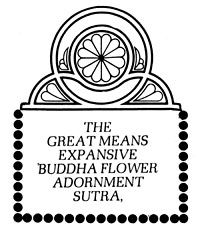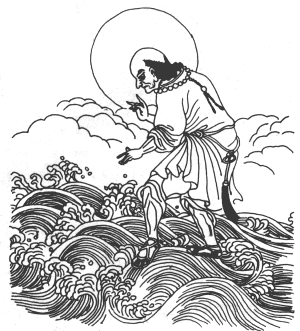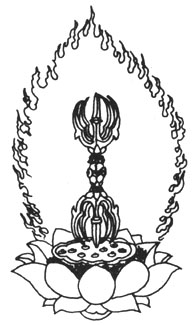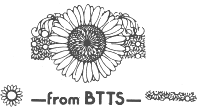|
If you were to
discuss the name of this Sutra in detail, you would not finish discussing
it to the exhaustion of the boundaries of the future. Not to speak of
five years, in fifty years it would not be spoken to the end. However,
we are not going to discuss it that way, but will just speak it very
simply; for whatever way you lecture the title of this Sutra is in accord
with Dharma. Therefore it is said:
Discussed
in horizontal terms,
Discussed
on the vertical plane,
Discussed
in terms of dust motes,
Discussed
on the scale of kshetras,
Any way it is
discussed it has infinite and inexhaustibly many principles. "Dust
motes" means subtle and minute particles, and "kshetras"
means large-scale lands or countries. Whatever way it is discussed
it has principle, and so this Sutra is truly one of no fixed Dharma.
Preface:
This Sutra
has thirty-nine chapters.
This
Chapter comes first.
Therefore
it is called THE GREAT MEANS EXPANSIVE BUDDHA FLOWER ADORNMENT SUTRA, THE
WORLD-RULES' WONDERFUL ADORNMENTS, CHAPTER NUMBER ONE.
Commentary:
The
number of chapters in the Flower Adornment Sutra is thirty-nine.
Originally there were forty-five chapters, but six chapters were not
translated from the original Indian language into Chinese. Nonetheless,
the Sutra has all of the requisite divisions:
1.
Prefatory Division.
2.
Division of the Text Proper.
3.
Division of Transmission.
Therefore,
it may be considered an entire Sutra, and so it says This Sutra, that is,
the present Flower Adornment Sutra, has thirty-nine chapters/All together
there are eighty rolls, eighty-one if one counts The Chapter of the
Conduct and Vows of Universal Worthy Bodhisattva. This
Chapter comes first/ "This Chapter" is The World-Rulers' Wonderful
Adornments Chapter. "Comes first" means that it was put in the front, at
the very beginning. Therefore, it is called THE GREAT MEANS EXPANSIVE
BUDDHA FLOWER ADORNMENT SUTRA, THE WORLD-RULERS' WONDERFUL ADORNMENTS,
CHAPTER NUMBER ONE/
The
Flower Adornment Sutra is the greatest among all the successive
teachings spoken by the Buddha. Previously, in the T'ang Dynasty, the
emperor T'ang T'ai Tsung (whose Reign Period was Chen Kuan) asked Dharma
Master Hsuan Chuang, "Which is the biggest of all the sutras spoken
by the Buddha?" Dharma Master Hsuan Chuang replied, "The Flower
Adornment Sutra is the biggest." T'ang T'ai Tsung wanted to
recite a
sutra, but he wanted to recite a big sutra, not a small one, which is why
he asked that question. "The Flower Adornment Sutra?" he asked
incredulously. At that time they were still using the Chin Dynasty
translation of the Flower Adornment Sutra in sixty rolls. Afterwards,
Dharma Master Shikshananda translated it, adding twenty rolls; but at that
time it only had sixty. "You say that the Flower Adornment Sutra is
the biggest, but the Great Prajna Sutra has six hundred rolls, while it
has only sixty. How can the Flower Adornment Sutra be the biggest?"
Dharma Master Hsuan Chuang then told him, "The Flower Adornment Sutra
is such that one single door can open limitless doors, in multi-layered
inexhaustibility. This Dharma is inconceivable, whereas the Great Prajna
Sutra is just a single door within the Flower Adornment
Sutra." Thereupon
T'ang T'ai Tsung exclusively recited the Flower Adornment Sutra.
The state
of the Flower Adornment Sutra is not something that you can
conceptualize.
You cannot conceive of it. In the Chin Dynasty, there was a Dharma Master
who made the first translation of the Flower Adornment Sutra, working in
Bodhimanda Monastery. Every day, right at the time when he was translating
the Sutra, from the pool of water in front of the hall there would appear
two youths, bounding and leaping, each one holding fresh flowers in his
hands. They would approach, light incense, and make offerings to that
Dharma Master. On those occasions it was not just the Dharma Master who
was aware of what was going on. Within the Dharma Assembly there were many
who knew of and saw those events—but not everyone saw them. Why was
that? It was because at that time there were people with deep, thick good
roots, all of whom had opened the Dharma Eye which enabled them to see
this. The reason the two youths came to make offerings to the Dharma
Assembly was that the Sutra had been stored in the Dragons' Palace for
several hundred years. Dragon Tree Bodhisattva appeared in this world
seven hundred years after the Buddha's entry to Nirvana. During that
seven hundred year period, no one knew about the Flower Adornment
Sutra,
which was stored away in the Dragons' Palace. Dragon Tree Bodhisattva went
to the Dragon Palace, read the Sutra once, remembered it, and transmitted
it to the world. The Dragon King was also very happy to have the Flower
Adornment Sutra circulate in the world. He didn't selfishly say, "My
Sutra in the Dragon Palace is an untransmitted secret, a hidden Dharma
which people are not permitted to know." He was not like that, but
instead was delighted that the Great Vehicle Dharma was being transmitted
in the world. He commissioned the dragon sons and grandsons to appear by
transformation as a pair of youths and make offerings to that Dharma
Assembly. The Dharma Assembly at that time was one in which the Sutra was
being translated, not one in which it was being lectured. Right when
people were translating, the two youths would appear and light incense
before
the Buddhas and make offerings of flowers. This is known as the Portent of
the Appearance of the Pair of Youths, and is an event about which most
Buddhists know.
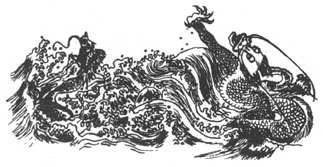
In the T'ang Dynasty, when Dharma Master Shikshananda had finished
translating the Flower Adornment Sutra, National Master Hsien Shou
preceded to lecture it. The translation was begun in the first year of the
Cheng Sheng Reign Period, the eleventh day of the third month, and took
until the second year of the Sheng Li Reign Period, the eighth day of the
tenth month, to complete. Right after the translation of the Sutra had
begun, the empress Wu Tsai T'ien, who was probably not far removed in time
from the Sixth Patriarch, had a dream. In the dream, in heaven and on
earth throughout the entire universe there fell sweet dew, no place being
without it. This made her very happy, and so she encouraged Dharma
Master Shikshananda to translate this Sutra. He translated the present
Sutra in eighty rolls, eighty-one rolls if one counts The Chapter of the
Conduct and Vows of Universal Worthy Bodhisattva, in thirty-nine
chapters. After the translation of the Sutra had begun, as it turned out,
rain fell and all the rain was sweet. That was an auspicious portent.
After
the Sutra had been translated, National Master Hsien Shou began to lecture
it at Buddha's Bestowal of Predictions Monastery. The lecture series began
on the fifteenth day of the tenth month. On the evening of the twelfth day
of the twelfth month, the Sutra had been lectured as far as the seas of
world-systems of the Flower Treasury, to where the earth quakes. Right
then, there was an earthquake! At that exact time the monastery all of a
sudden experienced an earthquake, and everything shook. On that occasion
there were several thousand people, both left-home and lay persons, who
had assembled there to listen to the lecture, all of whom felt the earth
quake. There had never been anything like that before, but it happened,
and so they called it "obtaining what had never before
existed." Thereupon, Dharma Master Shikshananda, along with a Vinaya
Master of the time named Ming Ch'uan and another Dharma Master named Te
Wei, composed an account of the earthquake and sent it to Wu Tsai T'ien.
When Wu Ts'ai T'ien, in her own hand, penned her remarks she said,
"Before you even wrote your account, I had already seen it. For at
the time of lecturing the Sutra, when this secret, hidden Dharma was being
propagated, in a dream I had already seen the sweet-dew portent, the omen
of the heavens universally raining down sweet dew. And now that the
lecturing of the Sutra has begun, for the earth to quake in six ways is
truly an inconceivable kind of state! This event should be broadcast
throughout the world, and everyone in the world should be informed about
this auspicious occurrence."
Now
while we are lecturing the Flower Adornment Sutra, the earth may quake in
six different ways, or various other kinds of things could happen. I'm
telling you in advance so that if the earth quakes you won't be afraid.
That is because when The Great Means Expansive Buddha Flower Adornment
Sutra is lectured, the earth trembles and quakes in six ways. They can
only be minor, not severe, earthquakes, because the good Dharma-protecting
spirits are protecting the Dharma Assembly. Even then, there are also
demon kings who come to trouble the Dharma Assembly; and so when, as
regularly happens, people come and pound on the door, you should not move
your minds. The Flower Adornment Sutra should be lectured with one's mind
in samadhi, which is how Shakyamuni Buddha spoke it; and all the
Bodhisattvas listened to the Sutra with their minds in samadhi. It was in
samadhi that the Dharma was spoken, so if something unusual should happen,
none of you should be afraid. There may be nothing—it's not fixed. There
is no fixed Dharma.
Some
people are bringing up a further problem, saying, "It is impossible
for the place where this Sutra is being lectured to have an earthquake,
because for a good many years now, Dharma Master, you have been telling us
that San Francisco cannot have an earthquake—that as long as you are in
San Francisco there will be no earthquakes; or if there are any, they will
be very slight. If there is an earthquake this year, won't that be a case
of contradiction between what was said before and afterwards?" Not
bad: it would be very contradictory. However, telling it not to quake when
it's time for it to quake, and telling it to quake when it's not time for
it to quake is a case of there being no fixed Dharma. As it happens, one
of my disciples called me on the phone a few days ago and questioned me
that evening saying, "Everyone says there's going to be an earthquake
in New York tomorrow. If there's certain to be an earthquake, then I'll
come back sooner. If there's not going to be an earthquake, then I'll wait
until the fifth or sixth of next month." When I first replied to her
I said, "I don't know, because right now I'm not in New York and I
don't know what's happening in Mew York." After we had talked a
couple of minutes more, she asked again and said, "What about
it?" I said, "It's not serious. Don't be afraid. If the earth
quakes, it quakes. What are you doing paying attention to that?" Now
I read in the papers that there was no earthquake in New York, so this
matter has passed...Now, if we have an earthquake in San Francisco, it's
not serious, so don't be afraid. While we are lecturing The Great Means
Expansive Buddha Flower Adornment Sutra, perhaps some kind of
inconceivable state may manifest.
In the past, during the Pei Ch'i Period (479-501), the third son of the
emperor went to Wu T'ai ("Five Peak") Mountain to burn his
body as an offering to Manjusri Bodhisattva. On that occasion there was,
among his escorts, a eunuch by the name of Liu Ch'ien who, upon seeing the
emperor's son decide to burn himself as an offering to the Bodhisattva
Manjusri,
Sought the
emperor's permission to leave home himself. The emperor granted his
request, and after he had left home, he devoted himself to reading and
reciting the Flower Adornment Sutra. He was particularly sincere, and
was vigorous day and night, seeking some kind of response. After he had
cultivated for a certain time, his beard began to grow. Basically, eunuchs
do not have beards, but as he cultivated his beard started to grow and he
had all the masculine characteristics which eunuchs lack. After that he
opened enlightenment and went on to write the Flower Adornment
Treatise.
Upon completing it, he died with no illness.
There was
also the Elder Li who cultivated the Flower Adornment Sutra, reading and
reciting it. At one point he set out in search of a good place to
cultivate. As he was walking down the road, he met a tiger. The tiger
acted very friendly towards him. Basically, tigers harm people, but
when this one saw the Elder Li, it acted as if it were an old friend of
his. The Elder Li said to the tiger, "Right now I'm looking for a
place to cultivate and do my work. Can you help me find such a
place?" The tiger seemed to nod its head, "Yes," and so he
piled all his gear upon the tiger's back for the tiger to carry. After
they had traveled some thirty miles, they came to a mountain cave. The
tiger stopped outside the cave and went no further. The Elder Li looked
inside and found the cave not bad at all; and so he stayed there to
cultivate. The only trouble was that the place had no water. However, that
very evening a great wind blew up, which uprooted an ancient pine-tree,
from the roots of which water flowed forth. So he used that water and
cultivated there, and wrote a treatise on the Flower Adornment Sutra.
There are very many states of that sort, all proving that the Flower
Adornment Sutra is inconceivable.
Gatha:
I
return my life to the ten directions' and the three times' utmost reach,
To
dust-mote kshetras' Taming Masters of perfect clarity,
To
the Dharma Realm's Great Compassion
Cloud
of merit and virtue,
To
Vairochana, the Great wisdom Sea;
To
the dwelling place most deep, the true Dharma Nature,
To
what flows forth whole and perfect as the Sutra;
In
each assembly of the Buddhas in each dust-mote,
To
Universal Worthy, Manjusri, and all Great Lords.
I
now wish with my one hair's breadth of wisdom,
To
fathom the boundless Dharma Realm's vast void.
May
I receive the Triple Jewel's Compassion of Identity in Substance,
Each
phrase profoundly meshing with all Buddhas' intent.
May
I cause the Dharma Eye forever not to fail,
Exhausting
realms of living beings like Universal Worthy.
I
transfer this supreme good equally to all that live:
May
they, soon accomplish Bodhi's fruit of never-ending bliss!
Commentary:
National
Master Ch'ing Liang divides the discussion of this Sutra into four
sections. What was previously discussed was the General Preface and
Meaning of the Title. The passage of text now under consideration consists
of a sixteen-line gatha which National Master Ch'ing Liang expresses
before writing the Prologue and Commentary to the Flower adornment
Sutra.
I
return my life/means, 'I take refuge and return my life, giving it to
the ten directions' and the three times' utmost
reach/" The three
times are the past, the present and the future. This represents taking
refuge with all the Buddhas of the ten directions and the three periods of
time. To dust-most kshetras' Taming Masters/"Dust-mote kshetras"
are kshetra-lands many as fine particles of dust. "Taming
Master" is one of the ten titles of the Buddha. Of perfect
clarity/The wisdom of the Taming and Regulating Masters is perfect, and so
is their merit and virtue. They tame and regulate the living beings of the
Three Realms—the Desire Realm, the Form Realm, and the Formless
Realm—enabling them all to leave suffering and attain bliss. They think
up all sorts of methods of regulation to bring them into harmony and
tame them.
To
the Dharma Realm's Great Compassion Cloud of merit and virtue/To the
exhaustion of empty space and of the Dharma Realm, in the ten directions
and the three periods of time, extends the infinitely Great Compassion
Cloud of merit and virtue, that is, the Buddha. To Vairochana, the Great
Wisdom Sea/ "Vairochana" is translated as "Perfect,"
as "One of Great and Perfect Enlightenment." The Great Sea of
Enlightenment is the Great Wisdom Sea and the Great Sea of Wisdom is the
Great Sea of Enlightenment. These four lines praise and take refuge with
the Buddha Jewel. The next two lines constitute taking refuge with the
Dharma Jewel: To the dwelling place most deep, the true Dharma Nature/This
says there is nothing deeper than the true and actual Dharma Nature, which
is dwelt in. To what flows forth whole and perfect as the Sutra/The
Flower
Adornment Sutra.
The next
two phrases represent taking refuge with the Sangha Jewel, and so they
say: In each assembly of the Buddhas in each dust-mote/In each and every
one of the countries many as fine motes of dust, in all places throughout
the ten directions, all the Buddhas' Dharma Assemblies where all Buddhas
are speaking Dharma, To Universal Worthy, Manjusri, and all Great
Lords/Universal Worthy Bodhisattva is an important Bodhisattva in the
Flower Adornment Sutra. There are also Manjusri— "Wonderfully
Lucky"— Bodhisattva, "and all Great Lords"—many other
very great Bodhisattvas besides.
National
Master Ch'ing Liang now says, I now wish with my one hair's breadth of
wisdom/He means his wisdom is too small To fathom the boundless Dharma
Realm's vast void/How can one use as little as a hair's breadth of wisdom,
which is so very small, to fathom entirely the principle of true emptiness
so large as that of the Dharma Realm? It cannot be fathomed to the and,
and so National Master Ch'ing Liang goes on to say: May I receive the
Triple Jewel's Compassion or Identity in Substance/"I hope for the
fair and equal kindness and Compassion of Identity in Substance of the
Triple Jewel of the ten directions and the three periods of time. May
Each phrase of this Commentary which I am writing to the Flower
Adornment
Sutra be in accord with the intent of all Buddhas, profoundly meshing with
all Buddhas' intent/May it, in a deep way, be in harmony and tally with
the thought in the mind of all Buddhas."
The
first eight lines of this sixteen-line gatha express taking refuge with
the inexhaustibly infinite permanently dwelling Triple Jewel of the ten
directions. The following six lines request the permanently dwelling
Triple Jewel of the ten directions to come to National Master Ching
Liang's aid, be protective and mindful of him, and open his wisdom so
that each phrase of the commentary which he is writing will be in accord
with the Buddha's meaning; as it is said:
Above,
meshing with the Buddha's mind,
Below,
tallying with living beings' potentials.
In the final two
lines, he transfers the merit and virtue of the entire Commentary to the
Flower Adornment Sutra as a gift to the living beings of the Dharma Realm.
|
